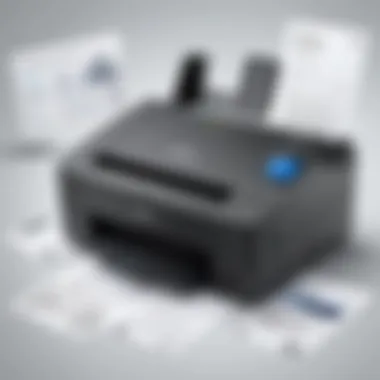Discover the Top Document Scanners for PCs


Intro
The need for an efficient document management system has become crucial in today's digital world. With vast amounts of paperwork and the emphasis on remote work, selecting a suitable document scanner for PC can be a daunting task. This guide aims to demystify the process by outlining essential features, assessing various models, and offering tailored recommendations for diverse user needs.
In this article, we will delve into the intricate factors influencing your choice of document scanner. We will focus on critical aspects such as scanning speed, resolution, and connectivity options. Assuredly, this thorough exploration will empower you to make well-informed decisions that align with your specific requirements.
Brief Description
Choosing the right scanner can greatly enhance productivity. Today's document scanners offer a myriad of features designed to cater to various market segments, from small business owners to large enterprises.
Overview of the Software
Most modern document scanners come with user-friendly software that simplifies the scanning process. This software allows for features such as image enhancement, batch scanning, and integration with cloud services. It's an essential component that complements the hardware capabilities of the scanner, ensuring a seamless experience. Scanning solutions like Epson Scan and Kofax are commonly used, providing various functionalities such as OCR (Optical Character Recognition) and easy file management.
Key Features and Functionalities
When looking for the best document scanner, consider the following key features:
- Scanning Speed: Measured in pages per minute (PPM), this metric is vital for efficiency.
- Resolution: A higher DPI (dots per inch) yields clearer images, crucial especially for text-heavy documents.
- Duplex Scanning: The ability to scan both sides of a document in a single pass can save time.
- Connectivity Options: USB, Wi-Fi, and network capabilities enhance usability across devices.
- Size and Portability: Depending on your environment, a compact scanner might be preferable for limited office space.
System Requirements
Understanding the system requirements is essential for optimal performance of your chosen scanner.
Hardware Requirements
Most scanners require a minimum of 2 GB RAM and a processor speed of at least 1.8 GHz to operate efficiently. The available USB ports should support USB 3.0 for faster data transfer.
Software Compatibility
Compatibility with operating systems such as Windows and macOS is crucial. Ensure that the scanner comes with the required drivers and software applications to facilitate usage with your PC. Scanners like Canon ImageFORMULA have robust support for various software platforms, enhancing their versatility in different environments.
"A well-chosen scanner can significantly streamline your document workflow, allowing for quick access and management of important files."
Prologue to Document Scanners for PC
In today’s digital age, the role of document scanners has grown significantly. It is essential for both personal and professional settings. This section aims to highlight why understanding document scanners is critical in selecting the best model for your needs.
When businesses shift towards paperless environments, document scanners play a key part in facilitating this transition. Efficient scanning saves time and improves organization.
Furthermore, with the vast array of options available, knowing the fundamentals of document scanners allows for better decision-making.
Understanding Document Scanners
Document scanners enable users to digitize physical documents. This technology transforms paper into electronic files, which can be stored, shared, or edited. Different types of scanners serve specific needs.
For instance, flatbed scanners are ideal for high-resolution scans of books and delicate documents. On the other hand, sheet-fed scanners are more efficient for bulk scanning. Understanding these distinctions helps individuals choose the right product based on their requirements.
Moreover, many modern scanners come with advanced features such as Optical Character Recognition (OCR). This technology facilitates the conversion of scanned text into editable formats. Recognizing these features can enhance workflow, especially in professional settings.
Importance of Scanning Documents
The significance of scanning documents cannot be overstated. First, it enhances accessibility. Scanned documents can be easily shared with colleagues or clients via email or cloud storage. This immediacy facilitates collaboration and decision-making processes.


Second, digitization reduces physical storage needs. Paper documents take up space and can be cumbersome to organize. By converting these files to digital formats, businesses can alleviate clutter and streamline their operations. In addition, storing documents digitally can improve data security. With proper backups, the risk of losing important files diminishes.
Key Features to Consider
Choosing the right document scanner involves understanding specific features that can significantly impact performance and usability. Each feature serves as a fundamental aspect influencing not only the efficiency of scanning but also the overall user experience. Being aware of these key features is essential for making an informed decision. Below, we delve into the various aspects that should guide your selection process.
Resolution and Image Quality
Resolution and image quality are paramount when selecting a document scanner. The resolution is measured in dots per inch (DPI), with higher DPI values providing more detail. For text documents, a DPI of 300 is often sufficient. However, for scanning images or intricate graphics, aiming for 600 DPI or more is advisable. Good image quality ensures that text is sharp and clear, particularly when using OCR (Optical Character Recognition) technology, which converts scanned documents into editable text.
We should also consider the scanner's image processing capability. Some models include automatic color detection or background removal features. This enhances the quality of scanned images, yielding better results for professional use. Here are a few points to remember:
- Higher DPI results in better detail but larger file sizes.
- Image enhancement features can lead to better readability and aesthetics.
Scanning Speed
Scanning speed is another critical feature that can affect productivity. Measured in pages per minute (PPM), speed is particularly important for users with high-volume scanning needs. Some advanced models can achieve impressive speeds, reaching up to 60 PPM or more. This is beneficial in settings where time efficiency is crucial, such as in offices or during large projects.
It's essential to balance speed with other features. Higher speed should not mean sacrificing image quality. Therefore, understanding the scanner’s efficiency across various scanning conditions and settings is equally important. Here are several things to consider about scanning speed:
- Look for the PPM rating relative to color vs. black-and-white scans.
- Test the scanner with different media types to gauge performance.
Connectivity Options
Modern document scanners must offer various connectivity options to accommodate different users. USB connections remain standard, but other options like Wi-Fi and Bluetooth are increasingly popular, especially in office environments. These wireless features allow for remote scanning and data transfer, enabling easier integration into existing workflows without the need for physical connections.
Moreover, cloud connectivity is becoming essential. Many scanners now provide direct access to cloud storage services such as Google Drive or Dropbox. This functionality may streamline your document management process, making it smoother.
When selecting a scanner, consider the following:
- Ensure compatibility with your current devices.
- Verify if it supports your desired cloud services.
Size and Portability
Size and portability play a significant role, particularly for users who may need to move their scanner between locations or workspaces. Larger scanners might offer additional features but can be cumbersome in limited spaces. Conversely, portable scanners cater to those requiring mobility without compromising on essential functionalities.
When evaluating size, assess the available workspace and how frequently you may need to relocate the device. Smaller, lightweight scanners can fit into a laptop bag, making them an attractive choice for professionals on the go. However, ensure that the features and specifications do not get overshadowed by the demand for portability. Key points include:
- Understand your scanning volume and space usage.
- Check for built-in features that justify the size.
Remember that the right balance of features can enhance your scanning experience significantly.
Choosing a document scanner is not merely about brand preference; it is about aligning product features with your specific needs. By focusing on resolution, scanning speed, connectivity options, and size, you can find a device that meets your expectations and enhances productivity.
Types of Document Scanners
Understanding the various types of document scanners is crucial for selecting the right one for specific needs. Each type comes with distinct features and advantages, catering to different workflows and applications. Choosing the right scanner can enhance productivity and efficiency in both personal and professional settings.
Flatbed Scanners
Flatbed scanners are a reliable choice for scanning various document sizes and types. They have a glass surface on which documents are placed, allowing for high-quality captures. These scanners excel in detail, making them suitable for photographs and delicate documents. The ability to scan books or bound materials without damage is another significant advantage. The downside, however, is that flatbed scanners tend to be slower than other types and may require more physical space. They are ideal for environments that value quality over speed, such as design studios or archival processes.
Sheet-fed Scanners
Sheet-fed scanners are designed for speed and efficiency. They work by automatically feeding an entire stack of documents through the scanner. This feature drastically reduces scanning time, making them suitable for busy office settings. They generally handle multiple pages per minute, which can significantly improve workflow. However, sheet-fed scanners may struggle with thicker or non-standard-sized documents, so users need to ensure compatibility with their typical scanning needs. They are best used in environments with high-volume document processing tasks, such as accounts payable departments or legal firms.


Portable Scanners
Portable scanners provide flexibility and convenience, appealing to users who need to scan documents on the go. They are lightweight and often battery-operated, making them perfect for travels or remote work. Despite their compact size, modern portable scanners feature impressive image quality and can handle various document types. However, their scanning speed may not match that of larger models, and the document capacity is usually lower. For professionals who frequently travel or work in multiple locations, a portable scanner can be a valuable tool.
All-in-One Printers
All-in-one printers merge printing, scanning, and sometimes copying and faxing functionalities into one device. This versatility is appealing to small businesses and home offices where space is limited. Many models offer decent scanning capabilities that cater to most occasional document scanning needs. While they might not provide the best quality or speed compared to dedicated scanners, their multifunctionality makes them a pragmatic choice for users requiring multiple functions without additional hardware. To ensure you have a good balance of quality and features, assessing all-in-one devices' specifications is essential.
Top Document Scanners for PC
In the realm of document processing, selecting the right scanner can significantly enhance efficiency. Document scanners come equipped with a variety of features that cater to the diverse needs of users, from small business owners to IT professionals. This section delves into some of the top document scanners available for PC users, assessing how these options can benefit different work environments and budgets.
High-End Models
High-end document scanners are designed for those who prioritize performance and quality above all. These models often offer features such as high resolution, fast scanning speeds, and advanced connectivity options. One standout in this category is the Fujitsu ScanSnap iX1500. Known for its intuitive touchscreen interface and ability to handle colored documents, this scanner delivers excellent image quality. The Canon imageFORMULA DR-M260 is another impressive option, capable of high-capacity batch scanning and exceptional reliability.
Investing in a high-end model ensures durability and comprehensive functionality. Moreover, many of these scanners come with bundled software that enhances productivity through automatic document filing and various file format capabilities.
Mid-Range Options
Mid-range document scanners offer a balance between performance and price, making them a popular choice among professionals who need reliable but not extravagant features. The Epson WorkForce ES-500W is a prime example. Its wireless capabilities and versatile paper handling make it suitable for both home and office use. It also comes with easy-to-use software to simplify the scanning process.
Another notable mention is the Brother ADS-2700W. This scanner provides strong performance in terms of speed and scan quality for a reasonable price. Mid-range options typically cater to various environments, allowing users to acquire quality scanners without breaking the bank.
Budget-Friendly Scanners
Budget-friendly options do not sacrifice functionality for cost. These scanners are designed for users who require basic features without the need for advanced capabilities. The Visioneer Patriot H60 exemplifies an affordable yet effective choice, offering decent scanning speeds and image quality. Its simple setup appeals to many small business owners.
The HP ScanJet Pro 3000 s4 is another practical option. It provides an efficient scanning experience and is able to handle multiple document types, making it suitable for a variety of applications. Budget-friendly scanners make document scanning accessible to a broader audience, ensuring that both startups and established businesses can benefit from digitizing their paperwork.
"Choosing the right scanner ultimately depends on understanding your needs and budget constraints."
In examining the top document scanners for PC, it becomes clear that there is an appropriate model for every user, from high-end devices to budget-conscious solutions. Ultimately, the right choice will heighten productivity and streamline document management processes.
Comparative Analysis of Models
The comparative analysis of document scanner models serves as a crucial component in selecting the right device for personal or professional use. Understanding the specific attributes and overall value offered by each model plays a significant role in making an informed decision. This section delves into important elements such as pricing, user ratings, and performance metrics that reflect the strengths and weaknesses of various document scanners available in the market.
A thorough analysis helps potential buyers grasp the fundamental differences between models, tailored features that fit specific needs, and how each scanner aligns with industry standards. The comparison will shed light on essential considerations, offering insights that transcend mere specifications. By synthesizing user experiences with objective assessments, we aim to illuminate the path toward selecting a scanner that delivers reliability and quality.
Pricing and Value
When evaluating document scanners, pricing is often the first consideration for many consumers. The market is filled with options ranging from budget-friendly models to high-end systems, each offering distinct levels of functionality. The price must reflect the value provided, which encompasses features such as image quality, scanning speed, and durability.
Bidging the gap between price and capability requires careful inspection of what's included with each scanner. For instance, models such as the Fujitsu ScanSnap iX1500 are known not only for their advanced scanning technology but also for their long-term value due to robust build quality and reliable customer support. In contrast, more affordable options, like the Brother ADS-1700W, may attract consumers looking to save money but could lack in operational speed or additional features.
Moreover, considering long-term costs is vital. Not just the price of the initial purchase, but also maintenance, consumables, and potential repairs. A more expensive scanner might turn out to be cheaper in the long run if it offers greater reliability and lower maintenance needs. Finding this balance between upfront costs and long-term value is key for astute buyers.
User Reviews and Ratings
User reviews and ratings are an invaluable resource when performing a comparative analysis of document scanners. They provide real-world insights that transcend the technical specifications. Reviews often highlight aspects that may not be evident in product descriptions, such as ease of use, customer support experience, and reliability over time.
For example, many users of the Canon imageFORMULA R40 praise its efficiency and user-friendly interface, noting how it fits seamlessly into both a home office and a business environment. Conversely, poor reviews of a particular model can signal red flags, such as frequent jamming or inadequate software support.
When analyzing user feedback, an entire spectrum of opinions should be considered. An average rating can tell part of the story, but assessing a range of reviews helps form a holistic view of the product’s performance. This kind of analysis enables potential buyers to weigh options effectively and make selections based on shared insights from those who have already tested the models in question.


In summary, the comparative analysis of document scanners not only emphasizes the importance of understanding pricing and user feedback but also illustrates the need for a thorough evaluation of each model to make informed purchasing choices.
The section concludes with the reminder that an informed buyer is a successful buyer. Investing time in the comparative analysis will yield dividends in the quality of documents processed and the overall satisfaction with the chosen equipment.
Buying Guide for Document Scanners
Selecting the right document scanner involves understanding your specific needs and preferences. A buying guide acts as a roadmap in this process, helping you navigate your options with clarity. Knowing the key features can shape your decision-making and ensure you choose a model that will serve you well for years to come.
Identifying Your Needs
Before making any purchase, it is crucial to assess your requirements. This can reduce the overwhelming number of options available in the market. Consider the following aspects:
- Frequency of Use: How often do you plan to scan documents? For occasional use, a basic model may suffice. Daily use may require something more robust.
- Types of Documents: Are you scanning standard letter-sized documents, or do you need to handle larger formats like legal-size papers? Some scanners specialize in specific sizes.
- Quality and Resolution: Determine the necessary image quality. High-resolution scanning is essential for printing or archiving important documents.
- Portability: If you frequently travel or work remotely, a portable scanner may be beneficial.
Assessing these factors will help consolidate your search and enhance the chances of finding a scanner that meets your needs efficiently.
Where to Purchase
Once you know what features you want in a scanner, it's time to think about where to buy. You might consider the following options:
- Online Retailers: Platforms like Amazon, Best Buy, and Newegg often provide competitive prices and a wide variety. Reading customer reviews can offer insights into the performance of different models.
- Physical Electronics Stores: Visiting local stores allows you to see the scanners firsthand and evaluate their build quality. Store associates can also provide valuable advice based on your requirements.
- Manufacturer Websites: Sometimes, purchasing directly from the manufacturer can yield exclusive deals or bundles. Brands like Fujitsu, Canon, and Epson often have online stores with complete product ranges.
Always compare prices and features across different platforms. This can help you uncover the best deal available.
In summary, the buying guide serves as an essential framework for acquiring a document scanner that aligns with your needs. By identifying what specifications are vital for you and choosing the right purchasing platform, you optimize your chances of making a wise investment in your document management process.
Common Issues and Troubleshooting
Troubleshooting is crucial when it comes to document scanners. Users often encounter several issues that can hinder their scanning process. Addressing these problems not only enhances the user experience but also prolongs the lifespan of the devices. Understanding common pitfalls allows users to troubleshoot effectively, minimizing downtime and frustration.
Scanner Connectivity Problems
One of the most frequent issues users face involves scanner connectivity. These problems can arise from a variety of sources—ranging from faulty cables to incorrect driver installation.
- USB Connections: For direct connections, ensure the USB cable is securely connected to both the scanner and the PC. If the cable is damaged, replacing it may be necessary.
- Network Issues: For networked scanners, a stable Wi-Fi connection is paramount. Check the router settings and ensure your scanner is within range. Restarting the router might resolve temporary connectivity problems.
- Driver Issues: An outdated or incorrect driver can prevent proper communication between the scanner and computer. Verify that the latest driver from the manufacturer's website is installed for your specific model.
Tip: Regularly check the manufacturer's site for updates. This practice keeps your scanner functioning smoothly and efficiently.
Software Compatibility
Another area of concern relates to software compatibility. Scanners often come with proprietary software to facilitate image management and organization. Compatibility issues can result in incomplete functionalities or prevent the scanner from operating entirely.
- Operating System Compatibility: Ensure that the scanner software supports your version of Windows, macOS, or Linux. Refer to the specifications on the product page for this information.
- Third-Party Software: While many scanners are efficient with their provided software, they often integrate with third-party applications. Check if your desired applications—like Adobe Acrobat or Microsoft Office—recognize your scanner.
- Regular Updates: Software developers regularly provide updates for enhanced features and security patches. Keep your scanning software up-to-date to ensure it works well with the latest OS updates.
Understanding these common issues in scanner connectivity and software compatibility equips users with the knowledge to troubleshoot effectively. This approach reduces frustration and enhances productivity when using document scanners.
Closure
The conclusion serves a vital role in summarizing the insights gained from the exploration of document scanners. Understanding the nuances of selecting the right scanner is essential for both individuals and businesses. A good document scanner can increase productivity, reduce clutter, and improve the overall management of documents.
Final Thoughts on Document Scanners
In today's digital age, the need to efficiently manage documents is paramount. Document scanners bridge the gap between paper and digital storage, allowing users to convert physical documents into easily accessible electronic files. The right scanner can facilitate smoother workflows and enhance collaboration among teams.
When considering a document scanner, it is crucial to assess one’s specific needs. Factors such as the type of documents, scanning volume, and intended use can influence the choice. Users should weigh the importance of image quality alongside speed and connectivity options.
"The effective management of documents can significantly boost efficiency in both personal and professional environments."
For IT professionals, software developers, and businesses of all sizes, investing in a reliable document scanner can lead to enhanced operational efficiency. The information discussed throughout this guide helps inform the decision-making process for choosing the best scanner that fits individual requirements.
Finally, as technology continues to evolve, staying updated with the latest advancements in document scanning is beneficial. Whether opting for a high-end model or a budget-friendly solution, being informed will ensure that the chosen scanner will meet current and future demands.



